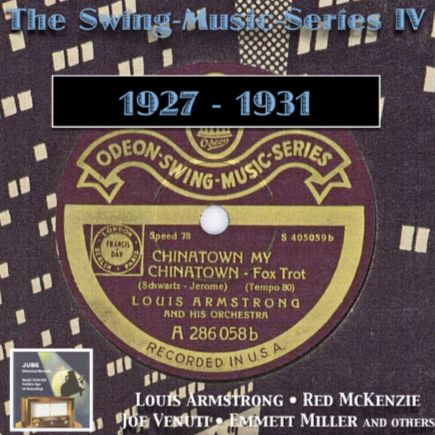On the Sunny Side of the Street: un hymne jazz à l’optimisme
Composée en 1930 par Jimmy McHugh, avec des paroles de Dorothy Fields, On the Sunny Side of the Street est longtemps restée entourée d’un doute persistant: certains affirment que Fats Waller en aurait été le véritable auteur, avant d’en céder les droits.
Créée dans la revue de Broadway Lew Leslie’s International Revue, interprétée par Harry Richman et Gertrude Lawrence, la chanson connaît un premier succès grâce à Ted Lewis, dont l’enregistrement atteint la deuxième place des classements. Mais c’est la version de Tommy Dorsey and the Sentimentalists, en 1945, qui s’impose comme la plus populaire, atteignant la 16e place des charts.
La véritable portée de ce standard ne peut se comprendre sans revenir au contexte de sa création: celui de la Grande Dépression. Dans une Amérique meurtrie, la musique devient un refuge, un souffle d’espoir. On the Sunny Side of the Street incarne alors une forme de résilience joyeuse: celle qui consiste à tourner le regard vers la lumière, même en pleine obscurité.
Sa structure harmonique, à la fois simple et subtile, repose sur un jeu entre majeur et mineur qui traduit musicalement ce passage de l’ombre à la clarté.
L’audace visionnaire de Coleman Hawkins
Le 8 mars 1934, à New York, Coleman Hawkins enregistre une version mémorable de On the Sunny Side of the Street, accompagné au piano par Ford Lee ‘Buck’ Washington. Cet enregistrement, réalisé alors qu’il est encore membre de l’orchestre de Fletcher Henderson, marque un jalon essentiel dans l’histoire de ce standard. Hawkins y impose une lecture novatrice, qui dépasse l’interprétation traditionnelle et ouvre la voie à une conception moderne du saxophone ténor en jazz.
À cette époque, Hawkins s’impose déjà comme l’un des artisans de la reconnaissance du saxophone ténor comme instrument soliste majeur. Dans On the Sunny Side of the Street, il met en avant la richesse harmonique de la chanson, en y ajoutant une profondeur nouvelle.
L’interprétation se distingue par un phrasé singulier et par une utilisation subtile des inflexions rythmiques. Hawkins joue avec le tempo, accentue les transitions entre tonalités majeure et mineure, et insuffle une intensité émotionnelle rare à la mélodie.
Ce qui frappe dans cet enregistrement de On the Sunny Side of the Street, c’est la capacité de Hawkins à moduler son timbre, à alterner densité et légèreté, et à utiliser les silences comme des respirations expressives. Sa manière de faire chanter le saxophone illustre la maturité d’un style qui, tout en restant ancré dans le swing, anticipe déjà certaines évolutions du bebop.
On the Sunny Side of the Street: un himno jazzístico al optimismo
Compuesta en 1930 por Jimmy McHugh, con letra de Dorothy Fields, On the Sunny Side of the Street ha estado rodeada durante mucho tiempo de una duda persistente: algunos afirman que Fats Waller fue su verdadero autor, antes de vender los derechos.
Estrenada en la revista de Broadway Lew Leslie’s International Revue, e interpretada por Harry Richman y Gertrude Lawrence, la canción obtuvo su primer éxito con Ted Lewis, cuya grabación alcanzó el segundo puesto en las listas. Sin embargo, fue la versión de Tommy Dorsey and the Sentimentalists, en 1945, la que se consolidó como la más popular, llegando al puesto 16 en los rankings.
El verdadero alcance de este estándar solo puede entenderse en el contexto de su creación: el de la Gran Depresión. En una América herida, la música ofrecía un refugio, un soplo de esperanza. On the Sunny Side of the Street encarna entonces una forma de resiliencia alegre: la de mirar hacia la luz incluso en plena oscuridad.
Su estructura armónica, a la vez sencilla y sutil, se basa en un juego entre mayor y menor que traduce musicalmente ese paso de la sombra a la claridad.
La audacia visionaria de Coleman Hawkins
El 8 de marzo de 1934, en Nueva York, Coleman Hawkins grabó una versión memorable de On the Sunny Side of the Street, acompañado al piano por Ford Lee ‘Buck’ Washington. Esta grabación, realizada mientras aún formaba parte de la orquesta de Fletcher Henderson, marca un hito esencial en la historia de este estándar. Hawkins impone aquí una lectura innovadora que supera la interpretación tradicional y abre el camino hacia una concepción moderna del saxofón tenor en el jazz.
En aquel momento, Hawkins ya se afirmaba como uno de los artífices del reconocimiento del saxofón tenor como instrumento solista principal. En On the Sunny Side of the Street, resalta la riqueza armónica de la canción y le otorga una profundidad inédita.
La interpretación se distingue por un fraseo singular y por el uso sutil de inflexiones rítmicas. Hawkins juega con el tempo, acentúa las transiciones entre tonalidades mayor y menor, e imprime a la melodía una intensidad emocional poco común.
Lo que impacta en esta versión de On the Sunny Side of the Street es la capacidad de Hawkins para modular su timbre, alternar densidad y ligereza, y emplear los silencios como auténticas respiraciones expresivas. Su manera de hacer cantar al saxofón ilustra la madurez de un estilo que, aun anclado en el swing, anticipa ya ciertas evoluciones del bebop.
On the Sunny Side of the Street: un inno jazz all’ottimismo
Composta nel 1930 da Jimmy McHugh, con testo di Dorothy Fields, On the Sunny Side of the Street è rimasta a lungo avvolta da un dubbio persistente: alcuni sostengono che il vero autore fosse Fats Waller, che ne avrebbe poi ceduto i diritti.
Debuttò nel varietà di Broadway Lew Leslie’s International Revue, interpretata da Harry Richman e Gertrude Lawrence. Il primo successo arrivò con Ted Lewis, la cui registrazione raggiunse il secondo posto in classifica. Ma fu la versione di Tommy Dorsey and the Sentimentalists, nel 1945, a imporsi come la più popolare, arrivando al 16° posto delle classifiche.
Il significato profondo di questo standard si comprende appieno solo guardando al contesto della sua nascita: quello della Grande Depressione. In un’America ferita, la musica rappresentava un rifugio, un soffio di speranza. On the Sunny Side of the Street incarna una forma di resilienza gioiosa: quella di saper volgere lo sguardo verso la luce, anche nei momenti più bui.
La sua struttura armonica, semplice e al tempo stesso raffinata, si basa su un’alternanza tra maggiore e minore che traduce musicalmente il passaggio dall’ombra alla luce.
L’audacia visionaria di Coleman Hawkins
L’8 marzo 1934, a New York, Coleman Hawkins registrò una versione memorabile di On the Sunny Side of the Street, accompagnato al pianoforte da Ford Lee ‘Buck’ Washington. Questa incisione, realizzata mentre faceva ancora parte dell’orchestra di Fletcher Henderson, segna una tappa fondamentale nella storia di questo standard. Hawkins vi impone una lettura innovativa che supera l’interpretazione tradizionale e apre la strada a una concezione moderna del sassofono tenore nel jazz.
In quel periodo, Hawkins si affermava già come uno degli artefici del riconoscimento del sassofono tenore come strumento solista principale. In On the Sunny Side of the Street mette in risalto la ricchezza armonica della canzone, conferendole una profondità inedita.
L’interpretazione si distingue per un fraseggio singolare e per l’uso sottile delle inflessioni ritmiche. Hawkins gioca con il tempo, accentua le transizioni tra tonalità maggiore e minore e infonde alla melodia un’intensità emotiva rara.
Ciò che colpisce in questa versione di On the Sunny Side of the Street è la capacità di Hawkins di modulare il timbro, alternare densità e leggerezza e utilizzare i silenzi come vere e proprie respirazioni espressive. Il suo modo di far cantare il sassofono illustra la maturità di uno stile che, pur restando ancorato allo swing, anticipa già alcune evoluzioni del bebop.
On the Sunny Side of the Street: a jazz anthem of optimism
Composed in 1930 by Jimmy McHugh, with lyrics by Dorothy Fields, On the Sunny Side of the Street has long been surrounded by lingering speculation: some claim Fats Waller was its true composer, having sold the rights early on.
Premiered in the Broadway revue Lew Leslie’s International Revue, performed by Harry Richman and Gertrude Lawrence, the song first gained traction thanks to Ted Lewis, whose recording reached number two on the charts. However, it was Tommy Dorsey and the Sentimentalists’ 1945 version that became the most popular, peaking at number 16.
The full impact of this standard is best understood within the context of its time: the Great Depression. In a wounded America, music became a source of comfort, a breath of hope. On the Sunny Side of the Street came to symbolize a joyful form of resilience—the choice to look toward the light, even in the midst of darkness.
Its harmonic structure, both simple and nuanced, plays on the contrast between major and minor, musically expressing a journey from shadow to brightness.
The visionary audacity of Coleman Hawkins
On March 8, 1934, in New York, Coleman Hawkins recorded a memorable version of On the Sunny Side of the Street, accompanied on piano by Ford Lee ‘Buck’ Washington. This recording, made while he was still a member of Fletcher Henderson’s orchestra, marks a pivotal moment in the history of this standard. Hawkins offers here an innovative reading that goes beyond the traditional interpretation and opens the way to a modern conception of the tenor saxophone in jazz.
At that time, Hawkins was already establishing himself as one of the key figures in recognizing the tenor saxophone as a major solo instrument. In On the Sunny Side of the Street, he highlights the harmonic richness of the song and brings to it a new depth.
The interpretation stands out for its distinctive phrasing and its subtle use of rhythmic inflections. Hawkins plays with the tempo, emphasizes the transitions between major and minor tonalities, and infuses the melody with a rare emotional intensity.
What is most striking in this version of On the Sunny Side of the Street is Hawkins’s ability to modulate his tone, to alternate density and lightness, and to use silences as expressive breaths. His way of making the saxophone sing illustrates the maturity of a style that, while rooted in swing, was already anticipating some of the evolutions of bebop.


